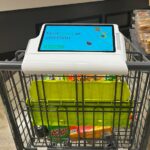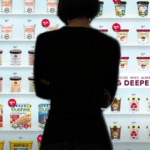
What’s not to like about blinkies? Nicknamed because of the blinking red light on top of the little automatic coupon dispensing machines, they can be a welcome surprise when you come across them in the grocery store. In this age of printable, digital and load-to-card coupons, though, they’re just a little old fashioned.
So one company is trying to bring blinkies into the 21st century. And in kind of a creepy way.
Mondelēz International, formerly known as Kraft Foods’ snack division, is working on what it calls “smart shelves”, to hold all of those impulse buys at the grocery checkout. They’re “smart”, because they can use advertisements and coupons to encourage you to make a purchase.
And they’re creepy, because they scan your face to help decide what will prompt you to buy.
If the “smart shelf” recognizes you as a middle-aged woman, for example, it might show an ad for a 100-calorie snack pack on an on-shelf display. If you’re a teenaged boy, it might steer you in the direction of a pack of gum, or a chocolate bar. And if you pick up an item, the smart shelf will sense that too, and could display an instant coupon for, say, $1 off two – in an effort to encourage you to grab one more.
“Knowing that a consumer is showing interest in the product gives us the opportunity to engage with them in real time,” Mondelēz Chief Information Officer Mark Dajani told the Wall Street Journal.
It’s certainly a lot more high-tech than sticking a blinkie machine in front of a product, and hoping the little red light will grab people’s attention.
A number of companies have been tinkering with facial recognition sensors, as a way of providing more personalized offers. Most of them insist that their technology won’t snap your photo or be able to recognize you as an individual. They say they’re just interested in categorizing you, in order to provide you with deals and coupons that you’re likely to be interested in. Rite Aid, for example, has begun rolling out “3D Reward Centers”, which not only feature a holographic display, but use video analytics to determine your approximate age and gender, so it can offer you appropriate coupons.
The difference is, you have the choice to engage with, or ignore, a 3D Reward Center kiosk. It will be harder to avoid a “smart shelf”. The mere act of looking at the products on such a shelf will trigger those personalized offers and coupons, whether you want them or not. It will also provide Mondelēz with lots of demographic data, about who its customers are and what they’re buying. And if it works at the checkout, it may well work throughout the supermarket someday soon.
“We must know how the consumer behaves in the store,” Dajani told the Wall Street Journal. So knowing who is buying, and not buying, could help them change up their product selection, or offer better coupons and incentives to pitch particular products to those who can be persuaded to buy. “When people walk by,” Dajani said, “it’s a missed opportunity.”
Mondelēz plans to begin rolling out its “smart shelves” in about a year. So consider that, the next time you stand there staring at a blinkie machine, waiting for it to spit out another coupon. By this time next year – the coupon machines could be watching you.











Just think of the ways our government could make use of this technology. They are already forcing the phone and internet companies to let them spy on us through our phones and email.
Let’s see…..They could increase our Obamacare rates if we buy too many unhealthy snack food items. Your health insurance company could send you an email saying, “We saw you bought four bags of chips and two boxes of cookies, and since you are already overweight, we must increase your premium for next month, unless we see you (via our cameras) working out at the gym twice a week for four weeks.”
Creepy. Very apt description: Creepy.
Since they’re ‘rolling out’ in a year, does this mean that they’ve already tested this? the public responded positively?
Personally, I don’t think I like the idea.
OR is this going to one of those stealth improvements to serve us better….like “pink slime”?
I’m sure that “pink slime” wasn’t the only time that the powers that be felt that the less the consumer knows-the better. 😉
P.S. Since I’m a fat, fat, fatty-they’ll be offering me one of those coupons to get me to buy 4.
They have a “prototype” so far – not sure if that means it’s been tested only technically, or in real-world conditions (in an actual store). But I suppose we’ll find out soon enough what consumers actually think about the idea – unless the camera is so tiny and there’s no disclosure on the smart shelf, so no one is ever aware or informed that they’re being profiled…
I can imagine a snag or two.
Someone is bound to sue because they are advertising to children.
And profile? Sketchy word that one. Screams racism. Another lawsuit?
Dang, you know as well as I do that its like navigating a mine field out there these days.
May not scream “racism”, but certainly violates privacy rights. The retailer has to disclose somewhere at the entrance they are using this technology for marketing purposes. It is NOT a generic men/women in age range 40-50, or 25-35, but a real identifiable face.